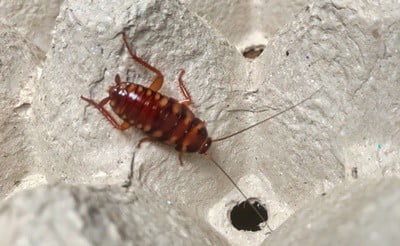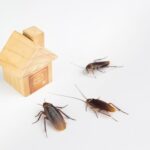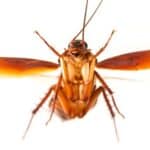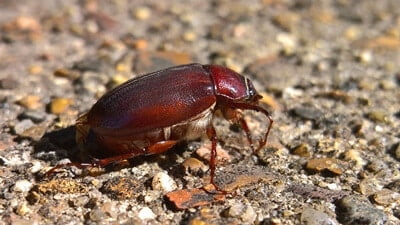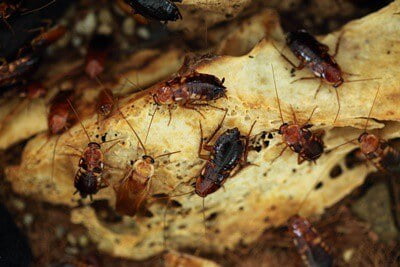The brown-banded cockroach lives in the Northeast, Midwest, and South of the United States. They are one of the most invasive species of all. In fact, brown-banded cockroaches can be rarely found in the wild anymore; they infest human homes almost exclusively.
The brown-banded cockroach is about ½ inch long and oval-shaped. It can be identified by the distinctive brown bands that stretch across its wings and back. Both the male and female have wings, but only the male can fly. They are known as the furniture roach because they like to infest sofas, chairs, beds, or anywhere hidden and warm. They also like high-up places, such as attics, shelving, and light fixtures.
These roaches can live for 206 days, and can even delay their growth when conditions are unfavorable. The species can reproduce at an exceptional rate, with a female creating up to 252 offspring in her lifetime. They easily transfer from home to home, especially in tight neighborhoods and apartment buildings.
Brown-Banded Cockroach Information
The supella longipalpa made its first appearance in the United States in 1903. Since then, they have spread across the entire country and up into Canada. However, they tend to prefer the:
- Northeast
- Midwest
- South
While not as prolific as the German or American cockroach, they can still be found worldwide. They were originally thought to be from Cuba, having traveled to Florida on merchant ships.
However, since this event, popular theories have argued that they hail from Africa. That would support their strong resemblance to the German cockroach and their preference for balmier climates.
The brown-banded kind is very resilient. It’s able to thrive in locales that aren’t similar to its original habitat. According to the Asian Pacific Journal of Tropical Biomedicine, that’s why it can infest restaurants, homes, and hospitals in Pennsylvania, Iran, and everywhere in between.
What we do know is that the supella longipalpa is a member of the ectobiidae family. They are often referred to as wood roaches. Other species of cockroach in this family are the:
- German cockroach
- Pennsylvania woods cockroach
- Asian cockroach
- Fulvous wood cockroach
- Virginia wood cockroach
- Small yellow cockroach
How To Identify Brown-Banded Cockroaches
The brown-banded cockroach is one of the smaller species. It measures about ½ inch long. This places it on equal footing with the German cockroach, if not a little bigger. At a glance, you can see that:
- Its body is flat, narrow, slightly oval-shaped
- It has wings that extend halfway down its back for females, or fully down its back for males
- It has 6 legs and 2 antennae
- It’s a light-brown color and may appear translucent in certain areas
The most notable features are the 2 brown bands that run around the wings and abdomen. The bands are lighter during the roach’s nymph cycle, but darker as it ages. This sets the roach apart from other cockroaches.
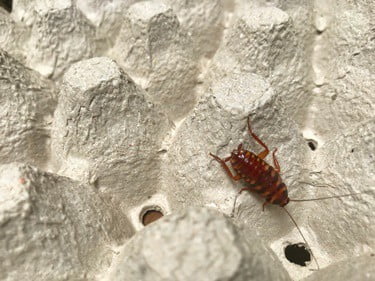
Brown-Banded Cockroach Eggs
The eggs are yellowish or reddish-brown. This depends on their stage of incubation, as well as the health of the mother. The closer the eggs are to hatching, the harder the shell will become and the darker its coloring will grow. You can find these eggs most commonly on:
- Walls
- Ceilings
- Inside furniture
If the roach population in your home is dense, the eggs will be laid in clusters. Multiple females will all pick the same hiding spot, which must be:
- Hidden
- Warm
- Near food
If you inspect the underside of your couch in the middle of an infestation, you may find as many as 20 egg sacs in one spot. The egg sacs are about 1/4 inch thick and contain 10-18 eggs in each.
Brown-Banded Cockroach Nymphs
In the nymph stage, the brown-banded cockroach will be a smaller version of its adult self. Aside from its tiny size, a notable difference will be the absence of wings.
Nymphs will not develop wings until later in their molting cycles. However, about 2 molts before they reach adulthood, the males will gain the ability to fly. Their aim and maneuverability will be limited. As such, most nymphs prefer to jump from place to place, instead of fluttering haphazardly. The wings give them enough lift to bounce.
The nymph phase will last anywhere between 80 and 124 days, depending on the temperature. They are officially adults once they reach their full size and begin reproducing.
Brown-Banded Cockroach vs. German Cockroach vs. American Cockroach
The brown-banded cockroach is often confused with the German cockroach. This is because they are both:
- Colored brown
- Similar in size
- Highly invasive and live almost exclusively indoors
- Winged and the ability to fly
The only way to tell these roaches apart is the presence of markings. As the name implies, brown-banded kinds will have stripes extending down their wings and abdomen. German roaches lack any distinctive markings.
American roaches are less frequently confused with brown-banded roaches. After all, the American cockroach is much larger and usually red. Even still, during the nymphal stages, an American roach can look like an off-color brown-banded roach.
Here are the most distinguishing features of each species. This will help you separate them at a glance:
| Brown-Banded | German | American | |
|---|---|---|---|
| Appearance | Light brown, with dark-brown bands on the back and wings. | Brown in color with no strong markings | Red-brown body with a gradient spreading downward |
| Size | About 1/2 inch long | 1/2 to 5/8 inches long | Between 1 1/2 to 2 inches long |
| Lifespan | 206 days | 3 to 6 months | 1-2 years |
Male Vs. Female
Cockroaches look mostly identical between sexes. However, there are a few characteristics that set a male and female apart in brown-banded roaches:
- The males have wings that cover their entire back. In contrast, the females have shorter wings that stop half-way.
- The female has a noticeably larger abdomen than the male.
- The female may carry an ootheca on her body, appearing like a bulbous pouch. The male will not.
- Only the males can fly. In a female, the short wings are only used for courting behavior and for protecting her body.
- The males are a lighter shade of brown than the females.
- Males average about 1/2 inch in length. Females are shorter but stouter.
If you observe a mating routine, you will also see a difference between the sexes. In other species, the males often take the lead, but it’s the opposite for the brown-banded cockroach. Instead, the females engage in unique courting behavior.
According to Annals of the Entomological Society of America, a female will raise her wings to signal her mate. She will also open and close her genitalia rhythmically, creating a small sound that signals her willingness to mate.
If the female does not call a mate, then she is unlikely to pair up. She can still draw his attention with the use of pheromones, but this is less effective. In fact, there is a 79% success rate vs. an 8% success rate.
Female brown-banded cockroaches will still lay eggs, even if they do not mate. The eggs will be infertile, and it will take longer for her to create another batch. For mated females, the process is much faster.
Where Do Brown-Banded Cockroaches Come From?
Unlike species that thrive in the wild, brown-banded cockroaches are often found in climates outside their ideal temperature range. Since they prefer 77-95 degrees Fahrenheit, they must find human shelter in the cold Northeast and Midwest locales.
That makes brown-banded cockroaches notorious in apartments or cul-de-sacs. They can travel between shared walls and nest in hidden places. They may get carried from home to home in boxes, clothing, or other items. They’ll infest vehicles, and often take up residence in furniture items.
That’s not to mention the danger of the eggs. They’ll lay dense clusters of ootheca in your home’s items, which can go unnoticed for several weeks. The brown-banded cockroach will often lay its eggs:
- Underneath furniture
- Behind pictures and paintings
- Inside cabinets
- Within closets
- Inside sofas
In fact, according to the University of Florida, they’re often called the furniture cockroach. They will hide in couches, sofas, recliners, and other dense materials. Since they’re small, they can easily thrive as a colony reaching upwards of 50 or more in a single piece of furniture. If overcrowding becomes an issue, they will spread out to infest other areas.
How Long do Brown-Banded Cockroaches Live?
The lifespan of brown-banded cockroaches is 206 days. From egg to nymph to adult, they may live within your home for over 6 months. With that said, a large amount of this time is spent as an egg and nymph. They will also spend more time in each phase, depending on how hospitable their surroundings are.
If brown-banded cockroaches grow up in a harsh environment, their adult life may be limited to only 6 weeks. However, if they grow up in a human dwelling with access to food, water, and warmth, they may live for over 4 months.
Upon reaching adulthood, females can immediately start breeding. A mother will create up to 252 offspring during her lifetime. This will be in batches of 10-18 at a time, contained inside 14 egg sacs across her lifespan. Because of this, and the brown-banded cockroaches’ willingness to invade homes, they can be a nightmarish infestation to deal with.
Brown-Banded Cockroach Life Cycle
Brown-banded cockroaches begin mating with the use of a sex pheromone. It’s called supellapyrone, according to the Tetrahedron Letters. The females emit it to attract males from a distance. In lab settings, researchers have been able to replicate the pheromone synthetically,
Upon testing it on roaches, they witnessed it causing a behavioral and electrophysiological response, according to the National Academy of Sciences. In other words, brown-banded cockroaches are a food-and-survival machine until this pheromone draws their attention to procreate and further the species.
After fertilization, the mother will house the eggs in an ootheca. This is a sac with a thick membrane, which is resistant to heat, cold, parasites, and even some kinds of pesticide. The durable nature ensures the offspring have a better chance of survival.
The female will carry the egg sac for about 30 hours as it properly forms and begins hardening. Once it’s prepared, she will then attach the ootheca to a flat surface. The incubation period for the eggs is 37 to 103 days.
They can delay hatching if temperatures are unfavorable, and speed up hatching if kept in warm, balmy places. Once they’ve emerged as nymphs, they will undergo several molts. It takes anywhere from 8 to 28 weeks to reach maturity. They can also delay molts and growth if the conditions around them are not favorable, and speed up growth as necessary.
What Do Brown-Banded Cockroaches Eat?
The brown-banded roach is a scavenger. Although its digestion is built to process rotting or decaying food, it has spent a long time in human dwellings. As such, its tastes have refined to enjoy human leftovers, organic waste such as hair, and even cardboard.
Most of all, the brown-banded cockroach prefers food with starch. That includes:
- Bread: Predominantly brown, wholemeal, and seeded bread
- Potatoes. These are extremely starchy, and brown-banded roaches are often found consuming the peels.
- Pasta. This starchy food can easily be infested when left dry in the pantry, cooked but misplaced on the kitchen floor, or in the fridge if the roach can gain access.
- Cereals. Bran and corn flakes are high in starch and may be contained in poorly-sealed paper boxes.
- Grains And Rice. These are an attractive food source for brown-banded cockroaches, and are usually put in flimsy containers.
If you limit their food options, brown-banded cockroaches are happy to adapt. They will seek out alternative food sources in:
- Wallpaper
- Stamps
- Envelopes
- Books
- Labels
- Color dyes
If truly pushed to their limit, brown-banded cockroaches will also resort to cannibalism. They may eat dead roaches, smaller roaches, nymphs, and eggs. This may also become a factor when overpopulation limits their food and space. They are one of the hardest species to starve out and almost always need heavier pest control methods.
Do Brown-Banded Cockroaches Bite?
The brown-banded cockroach is capable of biting, but does so rarely. It’s a small roach with tiny mandibles, so it will struggle to get a solid grip on your flesh. Likewise, it does not hunt live creatures, so will have no desire to target you. That’s not to mention that you are far larger, louder, and scarier than a roach, so it will always flee rather than confront you.
Brown-banded cockroaches only bite when they are attempting to eat dead skin flakes off of you. This may be during the night, and only if the roach is otherwise starving.
A roach may also bite if it’s stuck in close quarters with you. This is the case with heavy infestations, where you’re seeing multiple roaches every day, or every hour. The sheer numbers mean the roaches are trampling over you and each other. This can lead to wayward bites.
If a brown-banded cockroach bites you, wash the site with warm water and soap. These insects can spread disease, so the wound should then be disinfected. Watch for signs of infection, and if any develop, see a doctor.
Do Brown-Banded Cockroaches Fly?
Both male and female brown-banded cockroaches have wings. The males have long ones that stretch across their backs. This gives them the ability to fly short distances, but they cannot gain much height.
In contrast, the female wings are much shorter than the males. This makes them incapable of flight. A female will only use them to protect her body and to engage in courting behavior.
Brown-banded cockroaches are not active fliers. They will only use wings if they are startled and need to escape. They may also leverage the wings to glide down from high places or to gain access to lofty spots. However, most prefer to walk up cabinetry and walls instead. This draws less attention and is a more accurate means of navigating.
Where Are Brown-Banded Cockroaches In My Home?
Like most roach species, the brown-banded cockroach prefers areas that are dark, warm, and near food. They will avoid human contact when possible, electing to forage throughout the night. As such, you can expect them in:
- Kitchens
- Living rooms
- Bathrooms
- Dining rooms
- Bedrooms
Furniture is their ideal place, since it’s usually dark on the inside, insulated with material, and warm. However, they do have other options. Brown-banded cockroaches like warmth, and heat that rises. They may choose to nest in the high-up places of your living space. They’re prone to scurrying around and making nests in:
- Attics
- Lofts
- Shelving
- Cabinetry
- Hung-up clothing or decorations
- On or around light fixtures
In that search for warmth, you may also find them nesting in electronic devices. As long as there’s room to squeeze in, and it’s not often disturbed or moved, any appliance will do. Like German roaches, expect to find brown-banded cockroaches in:
- Fridge motors
- Gaming consoles
- Desktop towers
- Older TVs
- The wiring of ceiling fans
How to Identify Brown-Banded Cockroaches in Your Home
The most obvious sign of brown-banded cockroaches will be their droppings. You should look for little black specks or smears. All roaches will target the kitchen first, as well as garbage cans and pantries. What makes the brown-banded roach unique is its hiding place.
It will likely travel from cozier hiding places to your kitchen. Their nest will probably be in a large piece of furniture, a cushion, or even in clothing that’s stored nearby. If you have a coat rack or fabric chairs in your dining room, check there first. After that, expand your search to the living room and bedrooms, inspecting large furniture items.
If you’re coming up short, check out electronics that are constantly running, such as ceiling fans or even your computer. In all of these locations, you should watch for:
- More droppings or smears
- Discarded exoskeletons, which appear like small, hollow roaches
- Any small, darting movement
If the infestation is dense, you may have dozens of cockroaches hiding nearby. This will make them easier to find, but will no doubt be stressful to uncover. Pay attention to:
- A fluttering or scratching sound, such as multiple roaches crawling over each other
- A musty, oily smell, which comes from a dense amount of roach pheromones
How to Get Rid of Brown-Banded Cockroaches
It is crucial to remove any brown-banded cockroaches from your home. If allowed to stay and reproduce, they will grow into a highly-invasive problem. Aside from that, even one cockroach will be a carrier of viruses, disease, and illness, since it tramples through:
- Rotting food
- Trash
- Decaying plant matter
- Poop
- Body fluids
- Mold
- Fungi
- Organic waste
Because of this, brown-banded roaches are often coated in bacteria. They may also be coated in toxic chemicals. The colony in your home may have fled from another dwelling after they were driven out. They could be bringing traces of pesticide with them.
According to the University of Kentucky College of Agriculture, these pathogenic microbes can cause food poisoning and other illnesses. It is not uncommon for people to be allergic to the droppings left by cockroaches or the skins that they shed. The allergens will cause asthma-related symptoms, including:
- Coughing
- Sneezing
- Watery eyes
- Runny nose
- Breathing issues
Sanitation
Your first step must be to thoroughly sanitize your home. Before you can remove the cockroaches, you need to clear away bacteria and limit food sources.
Clean Your Home
If evidence of a cockroach infestation is present, then these areas need to be thoroughly sanitized. Kitchen utensils, toothbrushes, hairbrushes, and all surfaces may have been contaminated, so clean each of these items.
If the roaches are found in a room with carpeting, it is recommended that you first vacuum the entire floor and then shampoo the carpet. Doing this will pick up all the cockroach droppings and clean the area of pathogens.
Brown-banded cockroaches will glue their eggs to walls, ceilings, shelving, and furniture. Be sure to thoroughly scrub these surfaces down.
If you have a sofa or chair that is heavily infested, you may not be able to save it. It will be safer to just dispose of the item and replace it once the infestation is gone. If you must save it, then:
- Try isolating the furniture piece in your garage or a shed.
- You can activate a bug bomb underneath it
- Let it steep in this area for several days
- Check again after 1 week for signs of an infestation
Keep in mind that eggs may be resistant to this treatment. You may need to wait until they hatch and then try again.
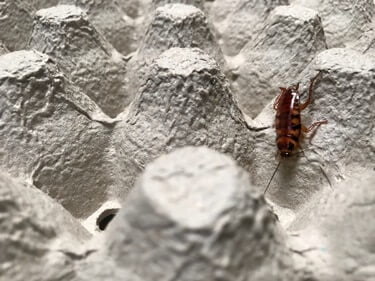
Package Up Food And Seal Pantries
Brown-banded cockroaches will find food anywhere, but you don’t have to make it easy. Be sure to remove all food from:
- Thin plastic bags
- Bread boxes on your countertop
- Cling-film or aluminum foil
Roaches may still gain access to the food through these. Instead, place everything in thick plastic containers. You should also check your pantries for holes, crevices, or other means of entry. If the roaches are getting in through the cupboard doors, then you should seal them tightly.
Set Up A Cleaning Routine
Keeping the home clean is the most effective way to prevent an infestation from getting worse. As you move on to pest control, be sure to implement this routine:
- Remove trash from the home every night before bed
- Clean up crumbs and spills from the floor and carpeting
- Degrease cooktops and the stove regularly
- Seal any leftover food in containers
- Wash dishes after every meal and don’t leave them overnight
Elimination
Brown-banded cockroaches must be removed with pesticides. They are often resilient against DIY methods, and cannot be effectively starved out.
However, you can try to deter them from certain areas while you set up traps, poison, and bait. This will drive the roaches toward your insecticides, while keeping them away from well-sealed pantries. Here are natural means of deterring brown-banded roaches short-term.
- Citrus fruits, like oranges, lemons, and grapefruits
- Cucumber
- Garlic
- Onion
- Lavender
- Eucalyptus
- Sage
- Vinegar
With those in place, you have a choice of several different poisons. These all work against brown-banded cockroaches.
Boric Acid
Boric acid is toxic to roaches. Once ingested, the cockroach will die within a few days or weeks. This depends on how much the roach eats and the surrounding temperature. Roaches that traipse through boric acid will also dehydrate and die, making it an effective trap.
Be sure to lace food with boric acid and place it at key places around your home. You can also sprinkle the dust around suspected nests and allow the bugs to walk through them.
Bait Traps
Bait traps can be purchased at hardware stores. Place them at key places around your home that roaches frequent. Be sure to leave the traps for several days or weeks, and do not disturb this area.
The bait will lure the roaches in, and the poison within can kill them. Depending on the brand, the poison may wait until the roaches have traveled back to their nest to properly activate. This allows you to eliminate the full colony.
Brown-banded cockroaches have adapted to the presence of humans better than most roaches, and they thrive wherever we live. To get rid of them, be sure to act fast. The longer they stay, the more invasive they become.
